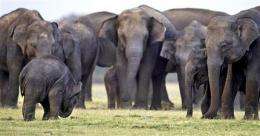Sri Lanka count finds more elephants than expected

(AP) -- The first national survey of Sri Lanka's wild elephants found more than had been estimated - a sign the endangered species has a healthy, growing population on the Indian Ocean island.
The count conducted last month in forests and wildlife parks found 5,879 wild elephants, of which 122 are tuskers and 1,107 calves, Wildlife Minister S.M. Chandrasena said Friday.
Previous counts did not cover the entire island, but the end of a quarter-century civil war in 2009 opened former war zones to wildlife workers.
The information gathered from the survey will be used to devise plans to protect the endangered species, Wildlife Department Director General H.D. Ratnayake said.
The previous population estimate was 5,350 elephants, he said.
"These statistics show that Sri Lanka's elephants are in good health and that their population is growing," Ratnayake said.
Ratnayake said other details of the survey are still being processed and would be released later.
About 20 wildlife groups withdrew their support of the count, accusing the government of using it as a "smoke screen" for capturing the endangered animals and domesticating some of the young for use in Buddhist temples, tourism and labor.
Their accusation came after Chandrasena was quoted as saying 300 young elephants would be captured and handed over to Buddhist temples after the census. Elephants in elaborate costumes are often used in Buddhist ceremonies where they parade through the streets carrying the sacred relics of the Buddha.
Chandrasena has said he was misquoted and no wild elephants would be captured.
In the early 1900s, an estimated 10,000 to 15,000 elephants roamed wild on this tropical island off southern India. But poaching and the loss of habitat due to human activities such as deforestation for farming have taken their toll.
Wild elephants are increasingly entering villages in search of food, rampaging through houses, destroying crops and killing an estimated 50 people a year.
Around 250 elephants are killed annually, mostly by farmers defending their crops or villages.
The survey was conducted using the method known as "water hole count" and about 4,000 wildlife workers, farmers and villagers were deployed for three days at more than 1,500 locations across the country to survey the elephants as they come to water sources for a drink.
Previous elephant counts were confined to specific regions. One such census, in 1993, found 1,967 elephants, but it excluded the island's north and east, where a civil war was raging at the time. With the war's end in 2009, wildlife officials this time conducted the survey in the former war zones too.
©2011 The Associated Press. All rights reserved. This material may not be published, broadcast, rewritten or redistributed.




















